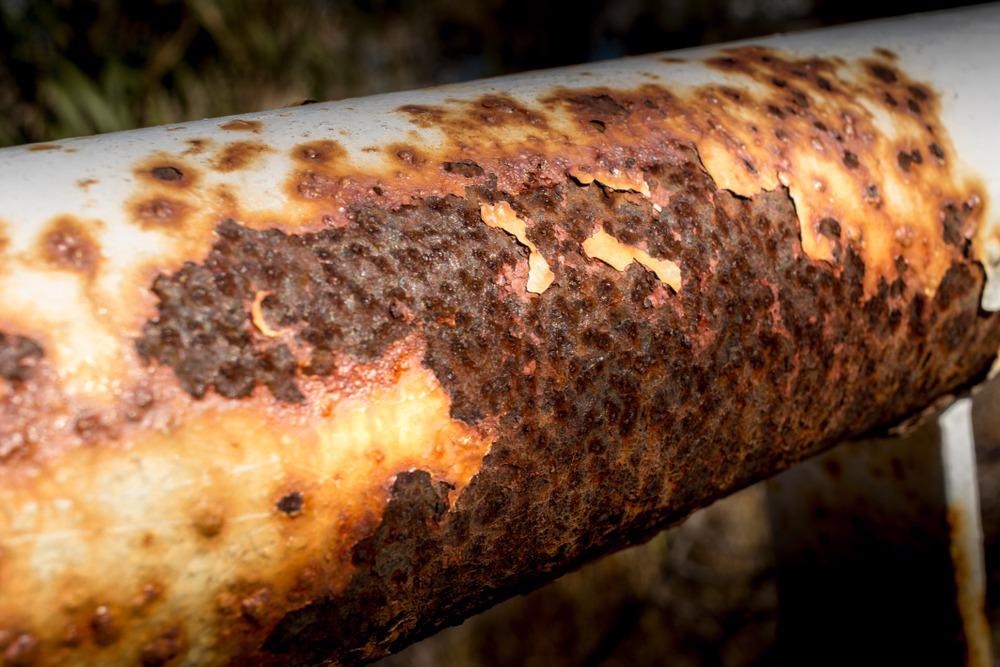An article published in the journal Materials Chemistry and Physics described a unique method of improving the anti-corrosive properties of carbon steel.

Study: Fabrication of Ni–Co/Cu super-hydrophobic coating with improved corrosion resistance. Image Credit: Guilbaud Stan/Shutterstock.com
The researchers used electrodeposition, chemical oxidation, and surface adjustment to create an ultra-hydrophobic Ni-Co/Cu nanocomposite lamination that can be applied on carbon steel surfaces.
Scanning electron microscope (SEM), X-ray diffraction (XRD), and water contact angle assessments were used to investigate the surface properties, structures, and wetting characteristics. Results showed that the water contact angle had increased to 158.61°, indicating an ultra-hydrophobic character.
Corrosion of Carbon Steel and How to Prevent It
Due to its decent mechanical qualities and low cost, high-strength carbon steel is frequently employed in maritime engineering. However, its low corrosion resistance in even moderate operating settings restricts its applicability.
Corrosion may reduce load-bearing capacity by lowering its overall size or by pitting, resulting in massive economic losses and accidents.
Preservative coating or lamination is the most widely used anti-corrosive technology among contemporary corrosion prevention technologies, which include cathodic shielding, anti-corrosive materials, and coating. One of the most industrially feasible and cost-effective processes for producing metallic, alloy, and metal matrix nanoscale composite coatings is electrodeposition.
Use of Nickel-Based Nanocomposites
Nickel (Ni) is a popular type of electroplating metal. Primary drawbacks of electrodeposited Ni include its poor firmness and limited resistance to wear.
Researchers have created Ni-based nanoscale composite coatings, such as Ni-CeO2 coating, to increase the performance of nickel coatings. Making numerous alloy coatings is another way to improve the performance of Ni coating. Because of its great wear and corrosion resistance, the nickel-cobalt (Ni-Co) alloy layer created via electrochemical deposition is critical for protecting carbon steel. Ni-Co alloy coatings are also more corrosion resistant than Ni coatings.
The inclusion of cobalt atoms causes a deformation of the solid solute framework and a decrease in porosity, which increases the coating's corrosion resistance. However, the presence of defects such as pinholes and hemp points calls for further enhancement of the surface quality and anti-corrosive behavior of nickel-cobalt coatings.
Ni-Co ultra-hydrophobic lamination has piqued the curiosity of many in recent years due to its ability to prevent corrosive media from penetrating and provide superior corrosion protection.
It is generally recognized that the most important variables in forming a super-hydrophobic surface are unique nanostructures and minimal surface energy. By altering the surface using organic compounds such as 1-dodecanethiol and silane, low surface energy may be readily achieved.
Building a good rough structure is a critical topic for research, and as more intricate parameter control is necessary, obtaining an adequately rough nanostructure surface via electrochemical techniques is significantly more challenging. Furthermore, the creation of rough surfaces necessitates a higher overpotential that may have a detrimental effect on the coating's protective efficacy.
The rough microstructures' manufacturing significantly restricts the practical uses of super-hydrophobic surfaces. As a result, it is important to design a simpler method of fabricating a rough structure on the Ni-Co lamination surface.
Electrodeposited copper and alloys based on copper are widely employed in a wide range of applications. Nanostructure formation on the surface of copper to generate an ultra-hydrophobic influence has received a lot of attention.
Chemical etching is one of the most used procedures for producing said nanostructures. It has the benefit of being easy to use and inexpensive.
Considering these benefits, a coating of copper is employed to provide Ni-Co with an ultra-hydrophobic characteristic.
A coating of copper was electroplated on Ni-Co lamination in this study, forming a composite Ni-Co/Cu coating which demonstrated super-hydrophobic properties after being treated with oxidation solution and dodecanethiol modification.
The benefits of this technology are as follows: (1) the high water-repellant impact of the Cu-coated surface development has been widely investigated, and the procedure is reasonably easy; (2) the need to perform stringent control on the nickel-cobalt coating development procedure is removed. Furthermore, the surface hydrophilicity and corrosion resistance mechanism of the Ni-Co/Cu composite coating were examined.
To Conclude
The Ni-Co/Cu ultra-hydrophobic lamination was created on a carbon steel substrate using a two-step electroplating process and dodecanethiol modification to increase corrosion resistance.
The findings demonstrated that this approach might increase the protective capacity of Ni-Co coatings by inhibiting hostile media from contacting the substrate, confirming the technology's appealing practical potential in maritime environments. This technology offers a novel way to enhance the effectiveness of Ni-Co coatings.
Continue reading: The Potential of Graphene As Eco-Friendly Corrosion Protection.
Reference
Lin, Z., Zhang, W., Zhang, W., Xu, L., Xue, Y., & Li, W. (2021) Fabrication of Ni–Co/Cu super-hydrophobic coating with improved corrosion resistance. Materials Chemistry and Physics. Available at: https://www.sciencedirect.com/science/article/pii/S0254058421012864?via%3Dihub
Disclaimer: The views expressed here are those of the author expressed in their private capacity and do not necessarily represent the views of AZoM.com Limited T/A AZoNetwork the owner and operator of this website. This disclaimer forms part of the Terms and conditions of use of this website.